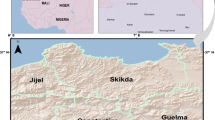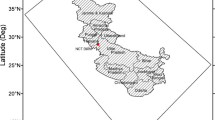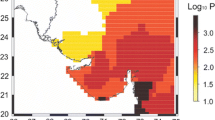Abstract
The Himalayan region and its surrounding area are one of the most seismically active zones in the world which have significant economic and societal impact. It governs the seismicity of highly populous countries like India, China, Pakistan, Nepal, Bhutan and Afghanistan which account for more than 40% population of the world. Therefore, the complex interaction between seismic parameters and transient seismic events needs to be thoroughly addressed at the regional scale. This study highlights the spatial distribution of earthquake hazard parameters and the temporal variation in seismicity of the Himalayas and its nearby regions by employing the maximum likelihood approach using historical records as well as instrumentally recorded earthquake data of the years 1900–2021. An empirical relation is developed to convert the body wave magnitude (Mb) and surface wave magnitude (Ms) to moment magnitude (Mw). The seismic parameters, namely maximum regional magnitude (Mmax), b-value, and mean seismicity rate (λ0), are estimated for 13 defined zones. Further, the seismic behaviours of the study area are evaluated through the return periods (RP) of earthquakes and the fractal dimension (Dc) of the individual zone. Considering the temporal variation of seismicity and RP of Mw ≥ 6, a new index , i.e. earthquake susceptibility index (ESI6), is developed to identify the zones which are susceptible to Mw ≥ 6 earthquakes. The zones: Central Himalayas 2 (CH2), Western Himalayas (WH), North of MCT 1 (NMCT1) and South of MCT 2 (SMCT2) are identified to be highly susceptible to earthquakes of Mw ≥ 6. The present analysis will motivate researchers and engineers from government and non-government organizations to collaborate for improved policy making in the seismically active Himalayan region concerning land-use planning, insurance, and catastrophe preparation.
















Similar content being viewed by others
References
Amitrano D (2012) Variability in the power-law distributions of rupture events. Eur Phys J Spec Top 205(1):199–215
Anbazhagan P, Smitha CV, Kumar A (2014) Representative seismic hazard map of Coimbatore, India. Eng Geol 171:81–95
Baruah S, Baruah S (2011) Moment magnitude–local magnitude relationship for the earthquakes of Shillong-Mikir plateau of Northeast India region. Mem Geol Surv India 77:141–148
Baruah S, Baruah S, Kalita A, Biswas R, Gogoi N, Gautam JL, Kayal JR (2012) Moment magnitude–local magnitude relationship for the earthquakes of the Shillong-Mikir plateau, northeastern India region: a new perspective. Geomat Nat Hazards Risk 3(4):365–375
Bayrak Y, Bayrak E (2012) Regional variations and correlations of Gutenberg-Richter parameters and fractal dimension for the different seismogenic zones in Western Anatolia. J Asian Earth Sci 58:98–107
Bayrak Y, Öztürk S, Çınar H, Kalafat D, Tsapanos TM, Koravos GC, Leventakis GA (2009) Estimating earthquake hazard parameters from instrumental data for different regions in and around Turkey. Eng Geol 105(3–4):200–210
Bilham R, Ambraseys N (2005) Apparent Himalayan slip deficit from the summation of seismic moments for Himalayan earthquakes, 1500–2000. Curr Sci 88:1658–1663
Bilham R (2019) Himalayan earthquakes: a review of historical seismicity and early 21st century slip potential. Geol Soc London Spec Publ 483(1):423–482
Bisht H, Kotlia BS, Kumar K, Dumka RK, Taloor AK, Upadhyay R (2021) GPS derived crustal velocity, tectonic deformation and strain in the Indian Himalayan arc. Quatern Int 575:141–152
Castellaro S, Mulargia F, Kagan YY (2006) Regression problems for magnitudes. Geophys J Int 165(3):913–930
Chandra U (1978) Seismicity, earthquake mechanisms and tectonics along the Himalayan mountain range and vicinity. Phys Earth Planet Inter 16(2):109–131
Chingtham P, Chopra S, Baskoutas I, Bansal BK (2014) An assessment of seismicity parameters in northwest Himalaya and adjoining regions. Nat Hazards 71(3):1599–1616
Chingtham P, Yadav RBS, Chopra S, Yadav AK, Gupta AK, Roy PNS (2016) Time-dependent seismicity analysis in the Northwest Himalaya and its adjoining regions. Nat Hazards 80(3):1783–1800
Cornell CA (1968) Engineering seismic risk analysis. Bull Seismol Soc Am 58(5):1583–1606
Cred U (2018) Economic losses, poverty & disasters 1998–2017. Université Catholique de Louvain (UCL), Brussels, Belgium, p 33
Das R, Meneses C (2021) A unified moment magnitude earthquake catalog for Northeast India. Geomat Nat Haz Risk 12(1):167–180
Das R, Wason HR, Sharma ML (2011) Global regression relations for conversion of surface wave and body wave magnitudes to moment magnitude. Nat Hazards 59(2):801–810. https://doi.org/10.1007/s11069-011-9796-6
Das R, Wason HR, Sharma ML (2014) Unbiased estimation of moment magnitude from body-and surface-wave magnitudes. Bull Seismol Soc Am 104(4):1802–1811
Das R, Gonzalez G, de la Llera JC, Saez E, Salazar P, Gonzalez J, Meneses C (2020) A probabilistic seismic hazard assessment of southern Peru and Northern Chile. Eng Geol 271:105585
Dasgupta S, Mukhopadhyay B, Mukhopadhyay M, Pande P (2021) Geo-and seismo-tectonics of Eastern Himalaya: exploring earthquake source zones from foredeep to Tibetan hinterland. Phys Chem Earth Parts a/b/c 123:103013
De la Torre TL, Monsalve G, Sheehan AF, Sapkota S, Wu F (2007) Earthquake processes of the Himalayan collision zone in eastern Nepal and the southern Tibetan Plateau. Geophys J Int 171(2):718–738
Gardner JK, Knopoff L (1974) Is the sequence of earthquakes in Southern California, with aftershocks removed, Poissonian? Bull Seismol Soc Am 64(5):1363–1367
Goitom B, Werner MJ, Goda K, Kendall JM, Hammond JO, Ogubazghi G, Illsley-Kemp F (2017) Probabilistic seismic-hazard assessment for eritrea. Bull Seismol Soc Am 107(3):1478–1494
Grassberger P, Procaccia I (1983) Measuring the strangeness of strange attractors. Physica D: Nonlinear Phenomena 9:189–208
Gupta ID (2006) Delineation of probable seismic sources in India and neighbourhood by a comprehensive analysis of seismotectonic characteristics of the region. Soil Dyn Earthq Eng 26(8):766–790
Gupta H, Gahalaut VK (2014) Seismotectonics and large earthquake generation in the Himalayan region. Gondwana Res 25(1):204–213
Gutenberg B, Richter CF (1944) Frequency of earthquakes in California. Bull Seismol Soc Am 34(4):185–188
Hamdache M, Peláez JA, Kijko A, Smit A (2017) Energetic and spatial characterization of seismicity in the Algeria-Morocco region. Nat Hazards 86(2):273–293
Hanks TC, Kanamori H (1979) A moment magnitude scale. J Geophys Res Solid Earth 84(B5):2348–2350
Herrmann M, Piegari E, Marzocchi W (2022) Revealing the spatiotemporal complexity of the magnitude distribution and b-value during an earthquake sequence. Nat Commun 13(1):1–10
Ismail-Zadeh A, Soloviev A (2022) Numerical modelling of lithospheric block-and-fault dynamics: what did we learn about large earthquake occurrences and their frequency? Surv Geophys 43:1–26
Iyengar RN, Chadha RK, Balaji Rao K, Raghukanth STG (2010) Development of probabilistic seismic hazard map of India. Report on the National Disaster Management Authority, Government of India, India
Jade S, Shrungeshwara TS, Kumar K, Choudhury P, Dumka RK, Bhu H (2017) India plate angular velocity and contemporary deformation rates from continuous GPS measurements from 1996 to 2015. Sci Rep 7(1):1–16
Kagan YY (2003) Accuracy of modern global earthquake catalogs. Phys Earth Planet Inter 135(2–3):173–209
Karim N (2007) Hazard mitigation in South and Southeast Asia. International perspectives on natural disasters: occurrence, mitigation, and consequences. Springer, Dordrecht, pp 211–230
Kayabali K (2002) Modeling of seismic hazard for Turkey using the recent neotectonic data. Eng Geol 63(3–4):221–232
Kayal JR (2001) Microearthquake activity in some parts of the Himalaya and the tectonic model. Tectonophysics 339(3–4):331–351
Kayal JR (2010) Himalayan tectonic model and the great earthquakes: an appraisal. Geomat Nat Haz Risk 1(1):51–67
Kijko A (2004) Estimation of the maximum earthquake magnitude, m max. Pure Appl Geophys 161(8):1655–1681
Kijko A, Sellevoll MA (1992) Estimation of earthquake hazard parameters from incomplete data files. Part II. Incorporation of magnitude heterogeneity. Bull Seismol Soc Am 82(1):120–134
Kijko A, Smit A, Sellevoll MA (2016) Estimation of earthquake hazard parameters from incomplete data files. Part III. Incorporation of uncertainty of earthquake-occurrence model. Bull Seismol Soc Am 106(3):1210–1222
Kolathayar S, Sitharam TG, Vipin KS (2012) Spatial variation of seismicity parameters across India and adjoining areas. Nat Hazards 60(3):1365–1379
Kumar S, Sengupta A, Hermanns R, Dehls J, Bhasin RK, Penna I, Gupta V (2022) Probabilistic seismic hazard analysis (PSHA) to estimate the input ground motions for Co-seismic landslide hazard assessment: a case study on Himalayan highways, Sikkim India. Phys Chem Earth Parts A/B/C 127:103157
Leptokaropoulos K, Karakostas V, Papadimitriou E, Adamaki AK, Tan O, İnan S (2013) A homogeneous earthquake catalog for Western Turkey and magnitude of completeness determination. Bull Seismol Soc Am 103(5):2739–2751
Liu J, Wang Z, Xie F, Lv Y (2013) Seismic hazard assessment for greater North China from historical intensity observations. Eng Geol 164:117–130
Mahajan AK, Thakur VC, Sharma ML, Chauhan M (2010) Probabilistic seismic hazard map of NW Himalaya and its adjoining area. India Nat Hazards 53(3):443–457
McGuire RK (1976) FORTRAN computer program for seismic risk analysis (No. 76–67). US Geological Survey,
Mignan A, Woessner J (2012) Estimating the magnitude of completeness for earthquake catalogs. Community Online Resour Stat Seismicity Anal 1–45
Mogi K (1962) Study of elastic shocks caused by the fracture of heterogeneous materials and its relations to earthquake phenomena. Bulletin of the Earthquake Research Institute, University of Tokyo, Tokyo, Japan, pp 125–173
Mohanty WK, Walling MY (2008) Seismic hazard in mega city Kolkata. India Natural Hazards 47(1):39–54
Molchan GM, Dmitrieva OE (1992) Aftershock identification: methods and new approaches. Geophys J Int 109(3):501–516
Mukhopadhyay B, Acharyya A, Bhattacharyya D, Dasgupta S, Pande P (2011) Seismotectonics at the terminal ends of the Himalayan Arc. Geomat Nat Haz Risk 2(2):159–181
Nath SK, Mandal S, Das Adhikari M, Maiti SK (2017) A unified earthquake catalogue for South Asia covering the period 1900–2014. Nat Hazards 85(3):1787–1810
Nayak M, Sitharam TG (2019) Estimation and spatial mapping of seismicity parameters in western Himalaya, central Himalaya and Indo-Gangetic plain. J Earth Syst Sci 128(3):1–13
NDMA (2011) Development of probabilistic seismic hazard map of India.
Öztürk S (2011) Characteristics of seismic activity in the Western, Central and Eastern parts of the North Anatolian Fault Zone, Turkey: temporal and spatial analysis. Acta Geophys 59:209–238
Pandey AK, Chingtham P, Roy PNS (2017) Homogeneous earthquake catalogue for Northeast region of India using robust statistical approaches. Geomatics Nat Hazards Risk 8(2):1477–1491
Polat G (2022) Spatial analysis of b-value variability in Elazig city and the surrounding area (Eastern Turkey). Acta Geophys 70(1):15–25
Prasath RA, Bansal BK, Verma M (2022) Stress distribution in the western India-Eurasia collision zone, its kinematics and seismotectonic implications. J Asian Earth Sci 230:105208
Priestley K, Jackson J, McKenzie D (2008) Lithospheric structure and deep earthquakes beneath India, the Himalaya and southern Tibet. Geophys J Int 172(1):345–362
Priyanka RS, Jayangondaperumal R, Pandey A, Mishra RL, Singh I, Bhushan R, Bhat GR (2017) Primary surface rupture of the 1950 Tibet-Assam great earthquake along the eastern Himalayan front India. Sci Rep 7(1):1–12
Raghukanth STG (2010) Estimation of seismicity parameters for India. Seismol Res Lett 81(2):207–217
Rajendran K, Parameswaran RM, Rajendran CP (2017) Seismotectonic perspectives on the Himalayan arc and contiguous areas: inferences from past and recent earthquakes. Earth Sci Rev 173:1–30
Reasenberg P (1985) Second-order moment of central California seismicity, 1969–1982. J Geophys Res: Solid Earth 90(B7):5479–5495
Ristau J (2009) Comparison of magnitude estimates for New Zealand earthquakes: moment magnitude, local magnitude, and teleseismic body-wave magnitude. Bull Seismol Soc Am 99(3):1841–1852
Roy PNS, Mondal SK (2009) Fractal nature of earthquake occurrence in northwest Himalayan region. J Indian Geophys Union 13(2):63–68
Sandhu M, Yadav RBS, Kumar R, Baruah S, Singh AP, Mishra M, Yadav JS (2022) Spatial variability of earthquake hazard parameters, return periods and probabilities of earthquake occurrences in the eastern Himalayan seismic belt. Phys Chem Earth Parts A/B/C 127:103194
Sawires R, Peláez JA, Santoyo MA (2022) Probabilistic seismic hazard assessment for Western Mexico. Eng Geol 313:106959
Schorlemmer D, Wiemer S, Wyss M (2005) Variations in earthquake-size distribution across different stress regimes. Nature 437(7058):539–542
Scordilis EM (2006) Empirical global relations converting MS and mb to moment magnitude. J Seismolog 10(2):225–236
Shanker D, Sharma ML (1998) Estimation of seismic hazard parameters for the Himalayas and its vicinity from complete data files. Pure Appl Geophys 152(2):267–279
Sharma ML, Malik S (2006) Probabilistic seismic hazard analysis and estimation of spectral strong ground motion on bed rock in north east India. In: 4th international conference on earthquake engineering pp 12–13
Singh AP, Roy IG, Kumar S, Kayal JR (2015) Seismic source characteristics in Kachchh and Saurashtra regions of Western India: b-value and fractal dimension mapping of aftershock sequences. Nat Hazards 77(1):33–49
Stepp J (1972) Analysis of completeness of the earthquake sample in the Puget sound area and its effect on statistical estimates of earthquake hazard. In: Proceedings of the 1st international conference on microzonazion, Seattle, Vol 2, pp 897–910
Stevens VL, Avouac JP (2015) Interseismic coupling on the main Himalayan thrust. Geophys Res Lett 42(14):5828–5837
Szeliga W, Hough S, Martin S, Bilham R (2010) Intensity, magnitude, location, and attenuation in India for felt earthquakes since 1762. Bull Seismol Soc Am 100(2):570–584
Taroni M, Akinci A (2021) Good practices in PSHA: declustering, b-value estimation, foreshocks and aftershocks inclusion; a case study in Italy. Geophys J Int 224(2):1174–1187
Thingbaijam KKS, Nath SK, Yadav A, Raj A, Walling MY, Mohanty WK (2008) Recent seismicity in Northeast India and its adjoining region. J Seismolog 12(1):107–123
Tiwari RK, Paudyal H (2022) Gorkha earthquake (MW7. 8) and aftershock sequence: a fractal approach. Earthq Sci 35(3):193–204
Tiwari A, Paul A, Singh R, Upadhyay R (2021) Potential seismogenic asperities in the Garhwal-Kumaun region, NW Himalaya: seismotectonic implications. Nat Hazards 107:73–95
Tsampas AD, Scordilis EM, Papazachos CB, Karakaisis GF (2016) Global-magnitude scaling relations for intermediate-depth and deep-focus earthquakes. Bull Seismol Soc Am 106(2):418–434
Turcotte DL (1997) Fractals and chaos in geology and geophysics Cambridge University. Press, New York
Turner B, Jenkins J, Turner R, Parker A, Sinclair A, Davies S, Benz HM (2013) Seismicity of the Earth 1900–2010 Himalaya and vicinity (No. 2010–1083-J). US Geological Survey.
Utsu T (1961) A statistical study on the occurrence of aftershocks. Geophys Mag 30:521–605
Utsu T (2002) Relationships between magnitude scales. In: Lee WHK, Jennings P, Kisslinger C, Kanamori H (eds) International handbook of earthquake and engineering seismology, Part A. Elsevier Science, Netherlands, pp 733–746
van Stiphout T, Zhuang J, Marsan D (2012) Seismicity declustering. Commun Online Res Stat Seism Anal 10(1):1–25
Verma RK (1991) Seismicity of the Himalaya and the northeast India, and nature of continent-continent collision. Phys Chem Earth 18:345–370
Vernant P, Bilham R, Szeliga W, Drupka D, Kalita S, Bhattacharyya AK, Berthet T (2014) Clockwise rotation of the Brahmaputra Valley relative to India: tectonic convergence in the eastern Himalaya, Naga Hills, and Shillong Plateau. J Geophys Res Solid Earth 119(8):6558–6571
Weatherill GA, Pagani M, Garcia J (2016) Exploring earthquake databases for the creation of magnitude-homogeneous catalogues: tools for application on a regional and global scale. Geophys J Int 206(3):1652–1676
Weichert DH (1980) Estimation of the earthquake recurrence parameters for unequal observation periods for different magnitudes. Bull Seismol Soc Am 70(4):1337–1346
Wiemer S (2001) A software package to analyze seismicity: ZMAP. Seismol Res Lett 72(3):373–382
Wiemer S, Katsumata K (1999) Spatial variability of seismicity parameters in aftershock zones. J Geophys Res Solid Earth 104(B6):13135–13151
Wiemer S, Wyss M (2000) Minimum magnitude of completeness in earthquake catalogs: examples from Alaska, the western United States, and Japan. Bull Seismol Soc Am 90(4):859–869
Wyss M, Gupta S, Rosset P (2018) Casualty estimates in repeat Himalayan earthquakes in India. Bull Seismol Soc Am 108(5A):2877–2893
Yadav RBS, Bormann P, Rastogi BK, Das MC, Chopra S (2009) A homogeneous and complete earthquake catalog for northeast India and the adjoining region. Seismol Res Lett 80(4):609–627
Yadav RBS, Bayrak Y, Tripathi JN, Chopra S, Singh AP, Bayrak E (2012) A probabilistic assessment of earthquake hazard parameters in NW Himalaya and the adjoining regions. Pure Appl Geophys 169(9):1619–1639
Yadav RBS, Tsapanos TM, Burton PW, Kumar R, Sandhu M (2022) Seismicity and magnitude recurrence hazard assessment in Eastern Nepal, Northeast India and Tibet Himalaya. Phys Chem Earth Parts A/B/C 127:103158
Yazdani A, Kowsari M (2017) A probabilistic procedure for scenario-based seismic hazard maps of Greater Tehran. Eng Geol 218:162–172
Acknowledgements
The first author acknowledges the Ministry of Human Resources Development (MHRD), Government of India, for providing the research fellowship during this study.
Author information
Authors and Affiliations
Contributions
SK contributed to the conceptualization, writing—original draft, methodology, and formal analysis. AS was involved in writing—review and editing and supervision.
Corresponding author
Ethics declarations
Conflict of interest
The authors declare no competing interests.
Additional information
Edited by Prof. Ramón Zúńiga (CO-EDITOR-IN-CHIEF).
Rights and permissions
Springer Nature or its licensor (e.g. a society or other partner) holds exclusive rights to this article under a publishing agreement with the author(s) or other rightsholder(s); author self-archiving of the accepted manuscript version of this article is solely governed by the terms of such publishing agreement and applicable law.
About this article
Cite this article
Kumar, S., Sengupta, A. Spatio-temporal analysis of seismic potential in the Himalayas and its nearby region: an insight from seismicity and earthquake susceptibility index. Acta Geophys. 72, 1483–1507 (2024). https://doi.org/10.1007/s11600-023-01210-5
Received:
Accepted:
Published:
Issue Date:
DOI: https://doi.org/10.1007/s11600-023-01210-5




